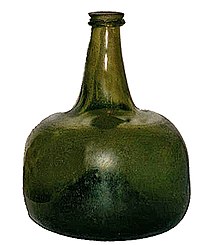Aging (wine)

Wine is one of the drinks that, under certain conditions , can benefit from temporary aging . While the term “ bottle aging ” or “ bottle maturity” is usually associated with a positive influence on the drink wine, the term “aging” encompasses the entire period between the end of alcoholic fermentation and the point in time at which the wine is inedible.
Ideally, the wine will improve over a period of time. An abundance of chemical reactions changes the wine aromas , smell, texture and taste, and the wine forms the so-called bouquet . The sugars, acids and phenols contained in the wine are involved in the reactions .
The ability to age depends on a large number of factors such as the grape variety , the vintage , the wine production, the wine-growing region and the desired type of wine (e.g. varietal wine, blend ( cuvée ), oxidative wine, etc.). Waiting for the optimal time to be ready to drink can be costly, as bottle storage increases the space and capital required , but does not necessarily increase the market value of the wine. A traditional method of storing wine is in wine cellars. The cellar mold that spreads there over time does not develop an unpleasant odor and thrives best under conditions that are also ideal for wine storage.
The story of the aging of wine
The ancient Greeks (→ History of Viticulture in Greece ) were already aware of the positive influence of correct storage of wines. Wines made from partially rosinated berries were very sweet and had good aging potential. The addition of resin , as it is still practiced in Retsina today, should make the wine more durable.
The Romans soon recognized the influence of the wine-growing region and the vintage. Falerner and Surrentiner were highly valued after 15 to 20 years of storage, as was shown by excavations in Pompeii . The aging of the wines should be accelerated by heating or smoking. However , we know from Galenos that he did not attribute the same healing power to artificially aged wines as to normally aged wines.
In the Gospel according to Luke it says: And no one who has drunk old wine wants new wine; because he says: the old wine is better . ( Lk 5.39 EU ) At that time, however, the tightness of the container was problematic: The wine was mostly stored and transported in earthen jugs and amphorae . Only small amounts were put into wineskins .
After the fall of the Roman Empire , progress in viticulture practically came to a standstill for over 1000 years. The market for expensive wines had collapsed in suitable areas. The wines of the former northern provinces of the empire were thin, spicy and low in alcohol. They only lasted a few months and were mainly for domestic use in the absence of clean water.
The term old wine in German (already in the language of the Middle Ages and the early modern period) usually describes any wine that is older than the last vintage.
With the technical mastery of Riesling , long-lived white wines were produced in Germany from the 16th century onwards , which benefited from the balance between steely acidity, sweetness and a constant cellar temperature of 12 ° C or less.
The improved techniques for making the glass bottle and the cork in the 17th century enabled great advances in the correct storage of wine. Before that, the wines were stored in large containers and the cellar master had to constantly refill the barrels in order to avoid oxidation due to direct oxygen contact on the wine surface.
In the 17th century, the English discovered fortified port wines , matured sherry and Madeira wine that was preserved by heat treatment (see also liqueur wine ). For the long sea routes to England and the British colonies, storable wines were required. With their demand, British wine lovers also had a lasting influence on the wine style of Bordeaux , which is still considered a reference for a long-lasting, dry red wine.
The increased demand for aged wines also changed the role of the wine trade , which was now also entrusted with storing young wines until they were ready to be drunk. In Beaune in the Burgundy wine-growing region , in the city of Porto and in Bordeaux in particular , the great influence and growing power of the wine merchants was evident.
literature
- Jancis Robinson : The Oxford Wine Lexicon, 3rd revised edition . 1st edition. Gräfe and Unzer Verlag, Munich, 2007, ISBN 978-3-8338-0691-9 .
- Michael Broadbent : Check out wines, know them, enjoy them . 3. Edition. Raeber Verlag, Lucerne and Stuttgart 1986, ISBN 3-7239-0040-2 .
- Pascal Ribéreau-Gayon, Denis Dubourdieu, Bernard Donèche, Aline Lonvaud: Traité d'oenologie, Microbiologie du vin. Vinifications . 5th edition. Dunod, Éditions La Vigne, 2004, ISBN 2-10-007301-X .
- Pascal Ribéreau-Gayon, Denis Dubourdieu, Yves Glories, Alain Maujean: Traité d'oenologie, Chimie du vin. Stabilization et traitements . 5th edition. Dunod, Éditions La Vigne, 2004, ISBN 2-10-007302-8 .
- Claude Flanzy (editor and coordinator): Oenology, Fondements scientifiques et technologiques . Lavoisier, Éditions Technique & Documentation, 1998, ISBN 2-7430-0243-3 .
